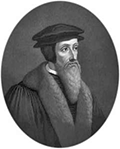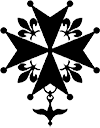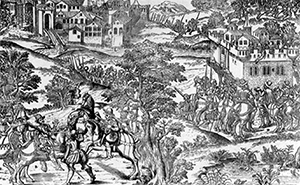The Huguenots: French Protestants
Part 1: Early Days and Freedoms Huguenots were French people who followed the religious teachings of the Protestant leader John Calvin. They numbered in the millions in the 17th Century but came under religious persecution and eventually, for the most, dispersed to other countries. 
Europe in the 16th Century was awash with discussions and conflict regarding religion. Perhaps the most influential leader of what came to be called the Protestant movement was the German monk Martin Luther who founded Lutheranism. Another well-known early Protestant leader was John Calvin (left), who was born in France in the early 16th Century and traveled throughout Europe, preaching the need to re-examine religious beliefs and practices. Calvin's ideas appealed to many people in France, and followers of Calvinism came to be known as Huguenots. The origin of the term is uncertain. Some historians think that the word is a combination of Flemish and German words; other sources say that the word came from one of the first leaders of the movement. The first Huguenots emerged in France in the first half of the 16th Century. A private home was the location of the first Huguenot church, in 1555. Four years later, representatives of 15 churches attended the first Huguenot synod, or church council meeting. Just two years later, in 1561, the country had more than 2,000 Huguenot churches and 2 million people professing that faith. 
The French King Henry II had signed the Peace of Cateau-Cambrésis with German princes in 1559. Those princes were Protestants. At the same time, Henry was a devout Catholic and targeted Protestants in his own country. Just after his ascension, he installed the Chambre Ardente in the Parlement of Paris, in order to try heretics. In the last year of his reign, he issued the Edict of Écouen, to further religious prosecution. He particularly targeted the Huguenots, with the 1551 Edict of Châteaubriant, which included a ban on unapproved books. Thus, the doctrine of religious intolerance had been set. It would eventually descend into the Wars of Religion, which raged for nearly 40 decades and killed millions of people. When Henry II died, in 1559, his wife, Catherine de Medici, presided over the kingships of three of his sons, ruling as regent for all of them. 
First up was Francis II, who ascended the throne when he was 15. Catherine and the Guise family, powerful Catholics, ran the government, with François Guise running the army and Cardinal Charles Guise taking care of financial and political matters. Francis had chosen to maintain the persecution policies of his father, and the Huguenots had had enough. On March 17, 1560, a large group of people, Huguenots among them, stormed the royal cháteau at Amboise; royal security had no trouble stopping the attack, and the king later ordered the leaders of the attack executed. Rather than keep the peace, these executions served to inflame the populace, and riots proliferated in various cities, notably Lyon and Provence. King Francis sent royal troops to disperse the rioters. Francis was on the throne for 18 months before he died, on Dec. 5, 1560. At that moment, his younger brother Charles became King of France; he was 10. As before, Catherine assumed the reins of government. Next page > Persecution and Warfare > Page 1, 2, 3 |
|
Social Studies for Kids
copyright 2002–2026
David White




